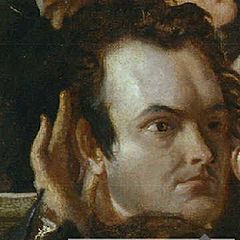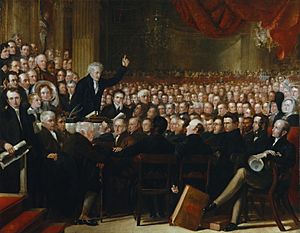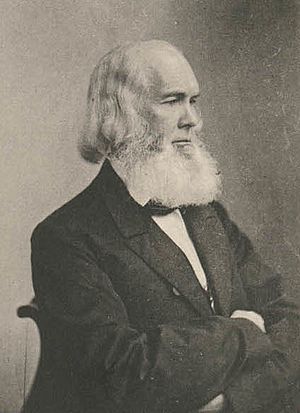George Bradburn facts for kids
Quick facts for kids
Rev. George Bradburn
|
|
|---|---|

Bradburn at the 1840 Anti Slavery convention, holding his hand to his ear.
|
|
| Born | March 4, 1806 Attleboro, Massachusetts, United States
|
| Died | July 26, 1880 (aged 74) |
| Education | Harvard Divinity School |
| Occupation | Unitarian Minister |
| Known for | Slavery abolitionist, Politician and lecturer |
| Spouse(s) | 1.Lydia Barnard 2.Frances Parker |
| Children | one died young |
| Parent(s) | James and Sarah Leach (born Hovey) Bradburn |
| Signature | |
George Bradburn (born March 4, 1806 – died July 26, 1880) was an American politician and a Unitarian minister. He lived in Massachusetts and was famous for supporting two important causes. He fought to end slavery and for women's rights.
In 1840, Bradburn went to a big meeting in London about ending slavery. There, he spoke up when women were not allowed to join the discussions. Later, in 1843, he was on a speaking tour with Frederick Douglass in Indiana when they were attacked. A writer named Lydia Maria Child said that George Bradburn had "a high place among the tried and true" because of his work against slavery.
Contents
George Bradburn's Life Story
George Bradburn was born on March 4, 1806, in Attleboro, Massachusetts. His parents were James and Sarah Bradburn. After his mother passed away, his half-sister Fanny raised him.
He first worked as a machinist, which is someone who builds or repairs machines. But when he was 19, he decided to go back to school. He studied at Phillips Exeter Academy in New Hampshire. Later, he attended the Harvard Divinity School to become a minister.
His first job as a minister was in Nantucket in 1831. Sadly, his church was sold while he was away, and his congregation (the people who went to his church) broke up in 1834. While in Nantucket, he married Lydia, his first wife. But she died within a year, and his only daughter died a year after that. These losses made him very sad for the rest of his life. He also started to lose his hearing.
Even with these difficulties, people respected him. In 1839, the Whigs elected him to the Massachusetts Legislature. He served there for three years.
In 1839, he joined the American Anti-Slavery Society. This group worked to end slavery. Bradburn helped pass a new law that changed marriage rules. In 1842, thanks to his efforts, people in Massachusetts could marry anyone they wanted, regardless of their skin color.
The World's Anti-Slavery Convention
In 1840, a big step was taken for women's rights in America. Abby Kelley became a full member of a committee for the American Anti-Slavery Society. Some members left the meeting because of this, but others, like the "Garrisonian wing," believed in equal rights for everyone, including women.
So, when an invitation came for the World Anti-Slavery Convention in London, England, it was no surprise that Massachusetts sent both men and women. George Bradburn, William Lloyd Garrison, and Wendell Phillips went. They also sent women like Lydia Maria Child, Harriet Martineau, and Maria Weston Chapman.
Bradburn traveled first class on a ship called the Roscoe on May 7, 1840. Other people fighting against slavery were on the ship too, including James and Lucretia Mott. After they arrived in England, many of them toured the country. Bradburn visited places like Blenheim Palace, Eaton Hall, Stratford on Avon, Oxford University, and Warwick Castle. He later used these travel experiences in his lectures.
Just before the convention started, the British organizer, Joseph Sturge, announced that women delegates would not be allowed to participate. This decision upset many people. Some American men, including George Bradburn, Wendell Phillips, and James Mott, supported the women. William Lloyd Garrison arrived later and refused to take his seat until women were treated equally. The American women had to sit with other female observers, like Lady Byron, and could not join the discussions.
The convention also debated whether people of all religions, or no religion, should be allowed to speak against slavery. Bradburn argued that no one should be excluded based on their beliefs.
The painting of Bradburn at the top of this article was made by Benjamin Robert Haydon. Haydon painted it in a small room at the Freemasons hall where the convention was held. Bradburn felt the painting made him look "too severe," but Haydon told him he looked "revolutionary" when he gave speeches. Bradburn visited France and then returned for a third sitting on August 3, 1840. After that, he visited Newcastle, Scotland, and Ireland. He met people he had known from the convention, including the Irish leader Daniel O'Connell and Lady Byron.
Speaking Out: The "100 Conventions" Tour
In 1843, Bradburn joined Frederick Douglass and William A. White on a speaking tour. The American Anti-Slavery Society organized this tour, called "100 conventions." They traveled to places where people might not agree with their message.
During this tour, Bradburn and Douglass were attacked. Douglass's hand was broken so badly that he never fully recovered. Other reports confirm that this attack happened in Pendleton, Indiana, on September 16, 1843.
From 1846 to 1849, Bradburn worked as an editor for a newspaper called "Pioneer and Herald of Freedom" in Lynn, Massachusetts.
Frederick Douglass once told a story in Ireland about Bradburn. Bradburn, who was almost completely deaf by then, was challenged by someone. The person said that ministers had to support slavery because they "must live." Bradburn replied, "I deny any such necessity — I dispute your premises. I deny that it is necessary for any man to live, unless he can live honestly." This showed his strong belief in doing what was right.
Later Life and Activism
In 1850, George Bradburn married Frances H. Parker in Boston. Later, Frances became ill, which meant Bradburn could not take jobs overseas. However, she was the one who eventually wrote his life story. That same year, he worked for the Boston Chronotype newspaper. He also attended the National Woman's Rights Convention in Worcester.
This convention lasted two days and had 268 delegates. Most of them were from Massachusetts. Many newspapers reported on the convention, but often in a negative way. Only a few local newspapers covered it fairly, and one of them was the Lynn Pioneer, which Bradburn edited.
In 1851, George and Frances moved to Cleveland, Ohio. There, Bradburn helped edit a daily newspaper called the True Democrat. After two years, he went on lecture tours. Sometimes, he would speak every night for 26 days! His talks were not just about politics. He also shared stories from his trip to Europe in 1840, making his lectures entertaining and informative.
In 1859, he became a minister at a Unitarian church in Athol, Massachusetts. He lived there for two years and made good friends. He returned to visit Athol every summer for the next twenty years. He later took a job in a customs house, arranged by his friend Samuel Chase. But he missed his ability to work as a speaker and activist. Near the end of his life, he called out to William A. White, a friend from his lecturing days.
Death and Legacy
George Bradburn passed away in 1880. At his funeral, Lysander Spooner read a speech praising him and helped carry his coffin. Bradburn's wife published his biography in 1883.
Lydia Maria Child wrote about him: "Surely in this country, and within this century, no other cause has so tested the moral natures of men and women, as did the anti-slavery cause in its early days: and no one who knew George Bradburn at that time will doing question his right to a high place among the tried and true." This means that fighting against slavery was a very hard and important cause, and George Bradburn was a truly brave and honest person who stood up for what was right.



